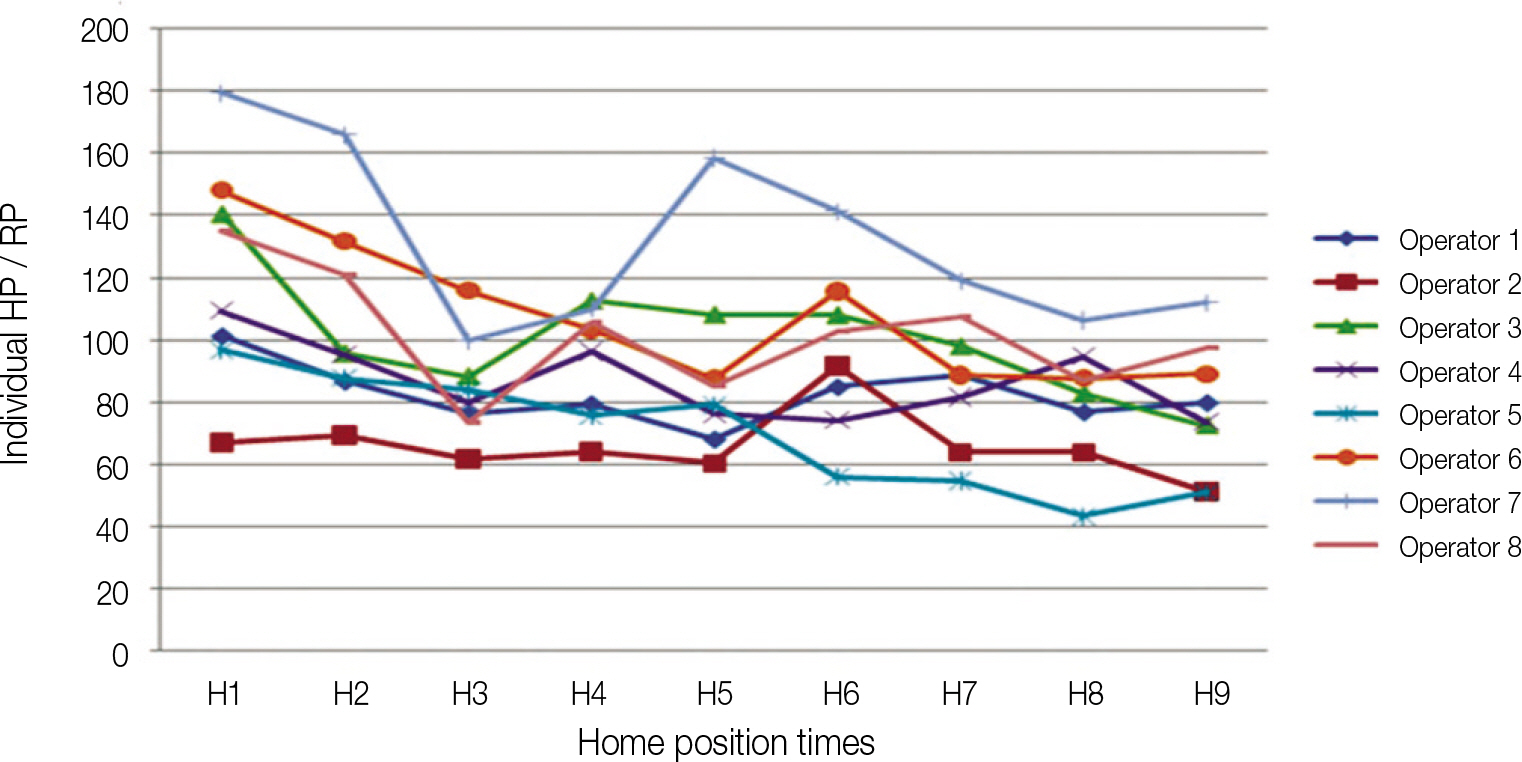J Korean Acad Prosthodont.
2011 Jan;49(1):38-48. 10.4047/jkap.2011.49.1.38.
An influence of operator's posture on the shape of prepared tooth surfaces for fixed partial denture
- Affiliations
-
- 1Department of Prosthodontics, Division of Dentistry, Graduate School, Kyung-Hee University, Seoul, Korea. choi@khu.ac.kr
- KMID: 2000282
- DOI: http://doi.org/10.4047/jkap.2011.49.1.38
Abstract
- PURPOSE
Dentists suffer back, neck and shoulder pain during their careers due to bad operating posture. If dentists have a good operating posture ergonomically, there would be less pain and discomfort in the shoulder and back. Therefore, dentists should learn the Home position which enables dentists to approach a stable posture ergonomically. This study was to compare tooth preparation in the Home position and the Random position, and evaluate the clinical efficacy of the Home position.
MATERIALS AND METHODS
Tooth preparation for fixed partial denture was performed on the maxillary left 2nd premolar and maxillary left 2nd molar at the two different operating positions were compared. The amount of occlusal reduction, marginal width, subgingival margin depth, and convergence angle were measured. A T-test was performed separately to compare the results of the Random position and the Home position.
RESULTS
1. The amounts of average thickness of occlusal reduction on fossa were deficient to the ordered ones in the Random position and the Home position (P > .05). 2. The average subgingival margin depth of prepared margin on maxillary left 2nd premolar, maxillary left 2nd molar were excessive in the Random position than in the Home position. On the maxillary left 2nd premolar, there was no statistical difference in the Random position and the Home position except Distal midline, DL line angle, Lingual midline, ML line angle (P < .05). On the maxillary left 2nd molar, there was no statistical difference in the Random position and the Home position (P < .05). 3. Average convergence angle in the Random position and the Home position were excessive compared to the ordered angle. There was no statistical difference in the Random position and the Home position (P > .05). 4. Analysis of pearson correlation : In the Random position, the amounts of average thickness of occlusal reduction, the average subgingival margin depth of prepared margin, convergence angle were significantly associated with each other (P < .05). But in the Home position, they were not significantly associated with each other (P < .05). 5. The time needed for preparation in the Home position was faster or equal than that of the Random position as time went on.
CONCLUSION
In conclusion, there were no significant differences between Home postion and Random position in measures of occlusal reduction, marginal width, marginal depth, convergence angle. However, preparation time and incidence of damaging adjacent teeth were less in Home position than in Random position. Therefore, if trained properly, Home position which is more ergonomically stable can be adopted for clinical use.
MeSH Terms
Figure
Reference
-
1.Erdil M., Dickerson OB. Cumulative Trauma Disorders: Prevention, Evaluation, and Treatment. John Wiley & Sons;1996. p. 88–9.2.Chowanadisai S., Kukiattrakoon B., Yapong B., Kedjarune U., Leggat PA. Occupational health problems of dentists in southern Thailand. Int Dent J. 2000. 50:36–40.
Article3.Jeon MJ., Sakong J., Lee JJ., Lee HK., Chung JH. Assessment of Job Related Cumulative Trauma Disorders of Dentists in Daegu Metropolitan City. Korean J Occup Environ Med. 2001. 13:55–63.
Article4.Choi MG. A study on the prevalence subjective symptom of musculoskeletal disorders & related risk factors among dentists in dental hospital. PhD Thesis. Department of Public Health, The Graduate School, Daegu Haany University, Gyeongbuk, Korea,. 2006.5.Choi DG. The influence of the dentist' s positions on the abutment tooth preparation of full cast crown: upper left second premolar. J Jpn Prosthodont Soc. 1986. 30:545–59.6.Lee SJ. The influence of home position and random position on the shape of prepared tooth surfaces: upper left 1st molar for full cast crown. PhD Thesis, Graduate School, Kyung Hee University, Seoul, Korea,. 2001.7.Oh YR. An influence of operator' s posture on shape of prepared tooth surfaces for full cast crown (maxillary right first molar). PhD thesis, Graduate School, Kyung-Hee University, Seoul, Korea,. 2009.8.Park NS. An influence of operator' s posture on shape of tooth surface preparation for full cast crown: mandibular right 1st molar. PhD thesis, Graduate School, Kyung-Hee University, Seoul, Korea,. 2010.9.Hwang SD. An influence of operator's posture to the shape of tooth surfaces preparation for full cast crown: mandibular left first molar. PhD Thesis, Graduate School, Kyung-Hee University, Seoul, Korea,. 2010.10.Kim SJ., Pae AR., Woo YH., Kim HS. Clinical convergence angle of prepared tooth for full veneer crowns. J Dent Rehab Appl Sci. 2010. 26:21–32.11.Shillingburg HT Jr., Hobo S., Whitsett LD., Jacobi R., Brackett SE. Fundamentals of Fixed Prosthodontics. 3rd ed.Quintessence Publishing;IL: 1997. p. 120–52.12.Annerstedt AL., Engstro ¨m U., Hansson A., Jansson T., Karlsson S., Liljhagen H., Lindquist E., Rydhammar E., Tyreman-Bandhede M., Svensson P., Wandel U. Axial wall convergence of full veneer crown preparations Documented for dental students and general practitioners. Acta Odontol Scand. 1996. 54:109–12.
Article13.Mack PJ. A theoretical and clinical investigation into the taper achieved on crown and inlay preparations. J Oral Rehabil. 1980. 7:255–65.
Article
- Full Text Links
- Actions
-
Cited
- CITED
-
- Close
- Share
- Similar articles
-
- Immediate fixed partial denture after tooth extraction in patients with systemic diseases: A clinical report
- Modified soft tissue cast for fixed partial denture: a technique
- Resin bonded fixed prosthesis for single tooth restoration: A case report
- An implant-supported removable partial denture for a patient with post-inflammatory scar contracture caused by burn complications: a clinical report
- Resin-bonded fixed partial denture using In-Ceram and Targis-Ventris system



